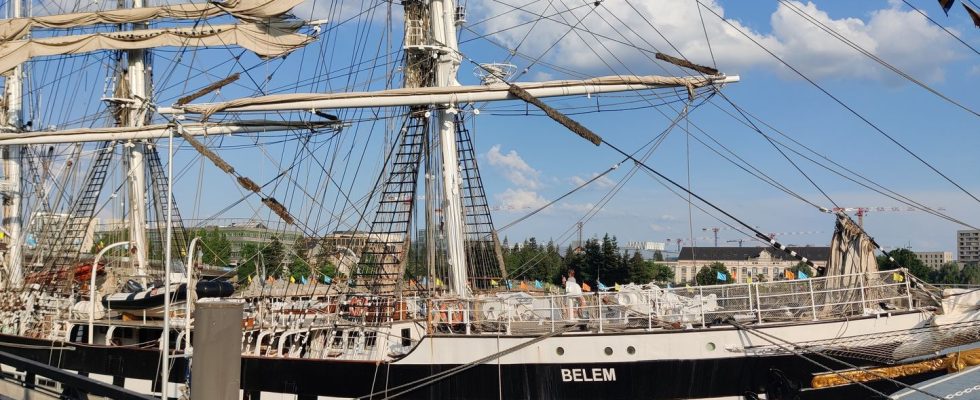It is a prestigious sailboat, which continues to sail and attracts a crowd of admirers at each stopover. Classified as a Historic Monument in 1984, the three-masted Belem has the immense honor this Saturday of transporting the Olympic flame from Greece to France. His arrival will be celebrated with great pomp on May 8 in Marseille. Famous for its elegant line, the Belem is less known for its extraordinary story, “incredible” even, considers the Belem Foundation, manager of the sailboat since 1979. It must be said that the sailboat built in Nantes 128 years ago is a “true miracle”, which almost disappeared five times. Narrative.
The ordeal of flames
Originally, the Belem is a ship intended for commerce. “He was going to get cocoa and sugar in Brazil for his main client in Nantes: the Meunier chocolate factory. The trading post he went to was called Belem, probably because it was in the same place as the current Brazilian coastal city,” explains Virginie Hinet, deputy general delegate of the Heritage Foundation.
Except that from its first crossing of the Atlantic, in 1896, the sailboat was put in difficulty by a storm, then by a fire on board. The cargo caught fire, dozens of mules perished, but the sailors managed to contain the flames. THE Belem escaped the worst for the first time, but not without some damage.
A volcanic eruption in the Antilles
In 1902, the Belem is in Martinique right at the time when an eruption of Mount Pelée devastates part of the island, in particular the port city of Saint-Pierre. “He only owes his survival to pure chance,” says Virginie Hinet. As he arrives in port, the captain realizes that another boat has taken his place. He will therefore return to anchor on the other side of the island. And that’s what saves him. The eruption started and all the other boats around Saint-Pierre sank. THE Belem was still hit by the ashes of the volcano. Today there remains a plate hanging in the commander’s office with marks of volcanic dust. » In 2002, the Belem returned to Martinique for the celebration of this eruption.
End of career and dismantling
At the dawn of the First World War, the rise of steamships was such that merchant sailing ships were doomed to be cast aside and dismantled. The career of Belem stop. Fortunately for the sailboat, it was spotted and bought in 1914 by the Duke of Westminster, who decided to transform it into a luxury yacht for his leisure. New comfortable rooms are built. “When the war broke out, while many sailing ships were destroyed, the Belem is isolated for the work. And therefore protected from combat,” reports Virginie Hinet. “Once again, he had a lucky star,” she smiles.
Bombings on the Isle of Wight
In 1921, the Belem is sold to Sir Arthur Ernest Guinness, vice-president of the famous Irish brewery. It was immediately renamed Ghost II and refitted for long voyages around the world. But the Second World War threatens and the sailboat is disarmed and sheltered on the Isle of Wight, where it will remain throughout the conflict. It will still be bombarded but only its rigging will be damaged. ” THE Ghost II remained the property of Guinness until 1951, when Sir Arthur’s heirs decided to sell it to Vittorio Cini, an Italian industrialist based in Venice. »
Abandoned in Venice
After its purchase in Italy, the sailboat was renamed Giorgio-Cini, in homage to the deceased son of the owner, and converted into a training ship. He retained this mission until 1968, when, considered too dilapidated, the boat was parked at the dock on the island of San Giorgio Maggiore in Venice. In 1972, the Italian gendarmerie, which wanted to recover it, began restoration work, which it was never able to finance. In compensation, the Giorgio-Cini is therefore transferred to the shipyards.
“It was painful to see. Despite the Venetians’ admiration for him, he was left in a corner, far from his past prestige. It was under these conditions, somewhat by chance, that a French doctor passionate about the navy (Luc-Olivier Gosse) recognized the Belem and made it known to the French,” says Virginie Hinet. In 1979, the three-masted ship, finally put up for sale, returned to France, bought by the Caisse d’Epargne as a sponsor.

